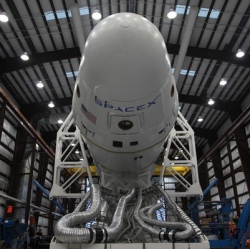
After nearly three years of work, President Obama just signed into law a piece of legislation that allows for private ownership of asteroids and space resources. Over the last 15 years, we’ve discovered a large population of asteroids that come very close to the Earth.
They are resource-rich, composed of materials that we find extremely valuable: fuels (hydrogen and oxygen), construction materials (nickel, iron, and cobalt), and platinum group metals (platinum, palladium, osmium, iridium) for strategic uses (like electronics).
Most of the large 250 meter to 1 kilometer rocks are worth trillions of dollars, and as such, they represent some of the most valuable real estate in our solar system. Even better, most of them are energetically easier to reach than the surface of the Moon.
You might have seen the headlines that read, "Jeff Bezos beats Elon Musk in space race to create reusable rocket." What is this all about? Building reusable rockets is really the key to low-cost space travel and therefore opening the space frontier.
On November 23rd, the day before Thanksgiving 2015, Jeff Bezos’ company Blue Origin pulled it off, they launched their New Shepard rocket to 329,839 feet (officially space, which is defined as 328,000 feet or 100 km), and it landed vertically back on Earth, with the ability to refuel and launch again.
But while the news media attempted to create a "Bezos vs. Musk" space race, they missed a few critical points: SpaceX had already demonstrated reusable vertical powered rocket landings years earlier with the Grasshopper “test vehicle” (as had SpaceShipOne with horizontal landings).
And, while New Shepard returned from 100 km altitude, it was only a suborbital vehicle (like SpaceShipOne) reaching a maximum velocity of Mach 3. This is in stark contrast to SpaceX’s Falcon-9 first stage return from near orbital velocities (Mach 3 vs. Mach 30).
Putting the media frenzy aside, what is most significant here is the growing commitment of private capital by billionaires like Elon Musk, Jeff Bezos, Paul Allen, Richard Branson and others in their attempt to open the space frontier.
Finally the future of space exploration and commercialization is no longer solely in the hands of a political process. Recently NASA announced that their "Mars Reconnaissance Orbiter (MRO) has provided the strongest evidence yet that liquid water flows intermittently on present-day Mars."
Using an imaging spectrometer on the MRO, NASA identified hydrated minerals with patterns unique to flowing water. Based on what we know about living organisms, you need to have water to have life. Our next Mars mission, scheduled to land on Mars in 2020, might discover that life exists there now.
The Mars 2020 Rover is a car-sized (10 x 9 x 7 foot) vehicle whose primary mission is to search for habitability and signs of life. But this is just the beginning of a much larger initiative around the Red Planet.
Elon Musk’s primary stated purpose in creating SpaceX is to help colonize Mars, to "make humanity a multi-planetary species." More specifically, two years ago he announced more concrete objectives to provide a roundtrip price of $500,000 per person to Mars within the next 20 years (actually, he said 15 years, but let’s cut him some slack). An Exciting Time to Be Alive.
Finally, while the race for asteroids, reusable rockets, and Mars is heating up, yet another race, the $30 Million Google Lunar XPRIZE, is about to take another leap forward. Stand by for news next week!
